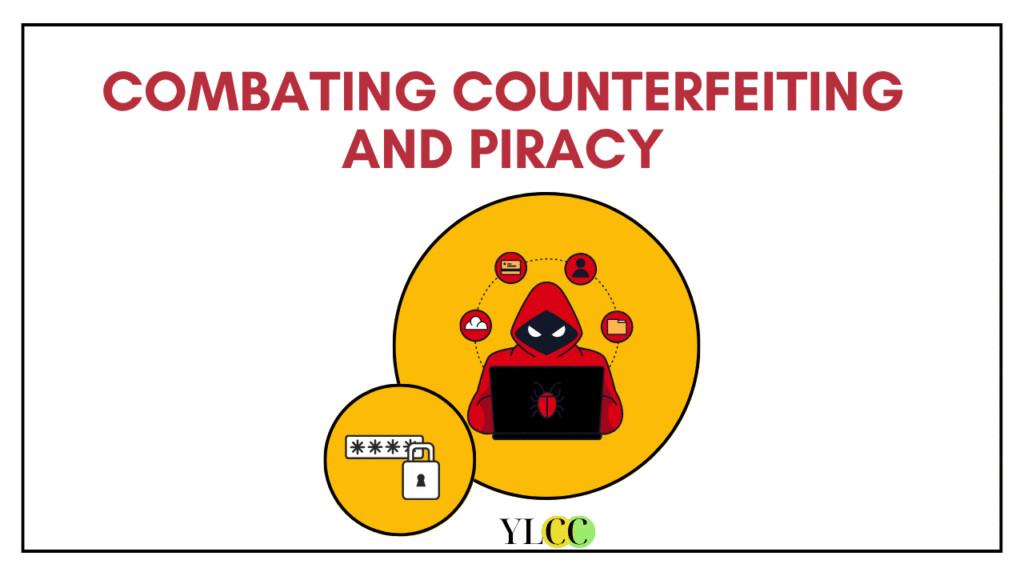
Counterfeiting and Piracy are illegal acts globally. In brief, Counterfeiting refers to imitation, which is fake or sometimes better than the original, usually with the intent to deceptively represent its content or origins. This increases sales appeal due to the reputation of the original brand product[1] (a violation of trademark or patents). On other hand, Piracy is an act of making complete copies without the consent of the right holder (a violation of copyright). Both Counterfeit and Piracy have become a global menace with time and technological development. However, no effective mechanism to curb this menace has developed so far.
Methods:
Some common methods include:
- Counterfeiting: It is common to both the offence as counterfeiters produce copies of documentation and packaging that are identical or deceptively similar to those of the authorized holder. These similarities are thereby used to sell goods against the rights of the due holder.
- Re-sellers: When the distributors or dealers make either copies of the product physically or in the internal storage of the computers to gain profit over them without giving due share to the right holder.
- Mail-order houses: Unauthorized copying into CDs or other media and distribution of such products by post. By this method, documented goods such as textbooks and manuals are easily pirated.
- End-user piracy: End user copying software into hard disks of more computers than the number authorized by the publisher. This is often seen with Anti-virus applications or games.[2]
Legal and regulatory frameworks:
At the macro level, it is generally perceived that India does not have an efficient system of protection against counterfeiting and piracy. However, the tides are turning against the offenders. Not just the legislative policies are more stringent but the judicial pronouncements have also undergone a radical change. The approach has altered from enforcement of mere injunctions to exemplary or punitive penalties.
Anti-piracy and Anti-counterfeit provisions are found under legislations like the Copyright Act of 1957, Trademarks Act of 1999, Intellectual Property Rights (Imported Goods) Enforcement Rules of 2007, Indian Penal Code (Now Bhartiya Nyaya Sanhita of 2023), Consumer Protection (E-Commerce) Rules of 2020 etc.
The Customs Act, of 1962 is prominent in this domain. As the majority of the counterfeited goods are imported across borders, customs prove to be the primary line of control. Section 11 of the Customs Act enables the protection of IP rights and prohibits infringement of patents, trademarks, or copyrights by conditions specified for the export or import of goods of particular descriptions.
However, customs currently doesn’t acknowledge parallel imported goods or goods procured in grey markets as prohibited goods, unless they have been smuggled or imported outside of their original packaging.[3] This leaves a large lacuna for the interplay of pirated goods in the Indian market.
A major institutional deficiency in the assessment of the legal framework showcases that these statutes do not treat the violation of intellectual property rights as a criminal act, and where they do, there is an essential stress over the “Mens Rea” (The mala fide mind). For example, the Indian Patent Act, of 1970 and the Design Act, of 2000, provide only civil liability. Though the Copyright Act 1957 and Trade Mark Act, 1999, provide for criminal liability, but sanctions are highly deficient and ineffective.[4]
The new avenues of vigilance and control can be opened via the implementation of statutes like the National Innovation Act, which unfortunately has remained a dead draft since 2008. It aims to promote research and innovation to detect and counter piracy and counterfeiting.
Strategies for detection and prevention:
As the methods of counterfeiting and piracy have increased manifolds due to the assistance of technology, tools to curb them are also drawn from technological development. Some of such strategies are:
- The state may offer e-consultation services to those who are victims of counterfeiting& piracy. Providing access to professional channels to get advice in complicated cases will expedite the process and make it effective.
- Manuals, cases, and data sets can be easily disseminated through the web to serve the public interest and reach out to the masses.
- Economic Partnership Agreements can be made across nations, bilaterally or multilaterally, to enhance free trade, ensuring IP protection transparency and enhancing investments, and personal exchanges.
- The state should focus on the development of human resources in law enforcement agencies to have effective implementation of the policies and regulations, ensuring they do not remain as a mere text. For ex., the customs and IPR-related agencies can be made more vigilant.
- Utilization of the potential behind the public-private joint missions can be a very efficient & effective strategy. Private forums assisting governmental bodies in vigil practice, in a future course on IPR protection enhancement and in cooperation over holistic improvisation of system and operations, can play a pivotal role.[5]
- Inter-industry dialogues can be delved into to crack down on the most evident forms of counterfeiting and piracy, including those on the internet. Opportunities exist in the field of standardizing tracking and tracing methods, possibly even across sectors, and user-friendly ways to authenticate original products.[6]
Risks and impacts of counterfeiting& piracy:
The risks and impacts of such malpractice spread over a wide range of communities from manufacturers to consumers and from government to socio-welfare bodies.
The national economy, security and welfare of the state face the maximum brunt from such illicit practices. This includes reduction in revenue due to tax evasion, high unemployment due to loss to businesses, exploitation of workers by forcing them to work on low wages, in unsafe and unhealthy working conditions, and exploitation of women, child labour and illegal immigrant workers for low-expense production by offenders.
The mala fide act further has long-term ill impact on the environment, and public health, which is hard to reverse. The bribes given to make counterfeited and pirated goods accessible in the market forms the ground to thrive criminals, terrorists and corrupt people. It leads to the downfall of market trust and consequently, foreign direct investment narrows.[7]
Other than this, there is a chain of direct impact on entrepreneurs, investors and manufacturers as well. It causes shrink in innovation and creativity component of entrepreneurs, damage to brand value and goodwill, reduced sales and profits of the enterprise, and additional costs of litigation for enforcement of IPRs.
Such malpractice risks the health of consumers/buyers and end-users by exposing them to low-quality goods in disguise. Less utility and satisfaction is derived from such goods, accompanied by total or partial loss of money.
Conclusion:
Conclusively, It is the need of the hour to stringently curtail illicit activities such as piracy and counterfeiting. These activities not only undermine the brand image of the company &deprive rightful owners of their earnings, but also discourage innovation and the development. Furthermore, they pose serious risks to consumer health and safety.
What is lacking is not the legislative provisions or conscience on the part of the state but the proactive attitude to promptly deal with the issue at hand. While robust legislation is important in this fight, the effective implementation of these laws is of even greater significance. It is witnessed that the implementation primarily fails in this domain due to lack of ascertainable defendants, leading to open-ended orders or “John Doe’ orders. Thus, the simpler, if not only, way out is a vigilant administrative body and aware consumers.
[1] Veer Singh, Combating Counterfeiting and Piracy: An Overview, 6 NALSAR Law Review, 17 (2011).
[2]Vineed Abraham, A Note on Anti-piracy Laws in India, Brands & Bonds, (last visited Feb. 25, 2025, 7:10 PM), https://www.brandsnbonds.com/updates/intellectual-property-right/a-note-on-anti-piracy-laws-in-india/.
[3]Ruchi Singh et al., India: Bolstered anti-counterfeiting regime champions stricter market regulation and enhanced consumer awareness, World Trademark Review (Feb. 25, 2025, 4:40 PM) https://www.worldtrademarkreview.com/guide/anti-counterfeiting-and-online-brand-enforcement/2023/article/india-bolstered-anti-counterfeiting-regime-champions-stricter-market-regulation-and-enhanced-consumer-awareness#:~:text=Legal%20framework%20in%20India&text=India%2C%20as%20a%20member%20of,trademark%20infringement%20and%20copyright%20piracy.
[4] Veer Singh, Combating Counterfeiting and Piracy: An Overview, 6 NALSAR Law Review, 17, 23 (2011).
[5] Yoshihiro Nagahashi, Counterfeiting and Piracy- A Global Overview, WIPO, chrome-extension://efaidnbmnnnibpcajpcglclefindmkaj/https://www.wipo.int/edocs/mdocs/aspac/en/wipo_ipr_pnh_11/wipo_ipr_pnh_11_ref_t2.pdf.
[6] European Commission, https://ec.europa.eu/commission/presscorner/detail/en/memo_10_272 (last visited Feb. 25, 2025).
[7] Veer Singh, Combating Counterfeiting and Piracy: An Overview, 6 NALSAR Law Review, 17, 20-21 (2011).
This article has been written by Astha. For any other queries, reach out to us at: queries.ylcc@gmail.com






